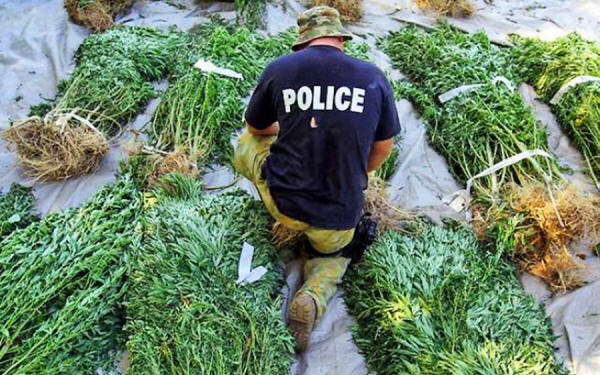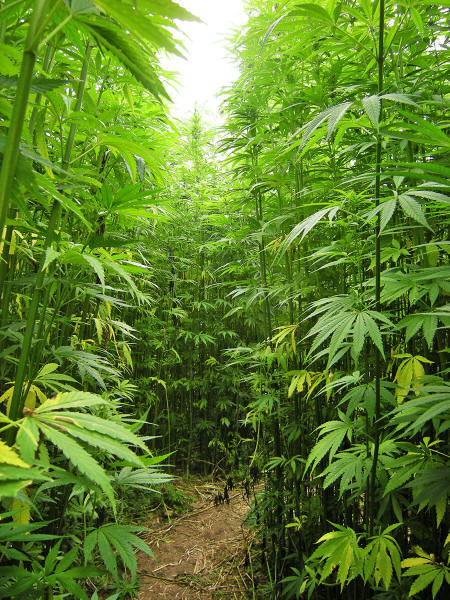from Collective-Evolution Website
To understand how cannabis became so stigmatized, you have to understand something about a plant that is very similar to cannabis but different enough that making it illegal would be preposterous:
If I told you there was a plant available to us today that could be grown in pretty much any soil, could thrive without the use of pesticides, and could be farmed with very little maintenance, and that this magical plant could be used for a very large number of necessities and goods we use today, but we are doing nothing about it, would you think to yourself,
Well, I'm not high nor do I get high, but let me tell you, there is a plant available right now and it is often mistaken for marijuana, but it has capabilities that are beyond what you could imagine.
It's called hemp...
Right off the top, hemp looks very much like marijuana and is technically in the same family of plants. But unlike modern maryjane, it does not contain anywhere near the amount of THC needed for someone to get high if they were to smoke it.
The funny thing is, in the United States, hemp is just as illegal to grow as marijuana is.
In the past, hemp was used for many things:
In fact, it used to be mandatory in the United States for farmers to grow hemp if they had the land.
More about hemp:
The fact is, hemp was very popular throughout the 1800s and 1900s because it was incredibly useful and easy to grow, and its derived products were so long lasting.
But one day that all changed; it became illegal and so did its friend cannabis (marijuana).
How did this happen...?
The History During Hoover's presidency, Andrew Mellon became Hoover's Secretary of the Treasury and Dupont's primary investor.
He appointed his future nephew-in-law, Harry J. Anslinger, to head the Federal Bureau of Narcotics and Dangerous Drugs.
Secret meetings were held by these financial tycoons.
Hemp was declared dangerous and a threat to their billion dollar enterprises. For their dynasties to remain intact, hemp had to go. This then led them to take an obscure Mexican slang word - 'marihuana' - and push it into the consciousness of America.
The reason why they changed the name was because everyone knew of hemp and how amazing it was for the world. They would never be able to get away with banning hemp, so they used a name they knew no one would recognize.
Not long after this plan was set in place, the media began a blitz of 'yellow journalism' in the late 1920s and 1930s.
Yellow journalism is essentially journalism where stories with catchy headlines are put into the mainstream media to get attention, yet these stories are not well researched or backed up. They are often used simply to sway public opinion.
Many newspapers were pumping stories emphasizing the horrors and dangers of marihuana.
The "menace" of marihuana made headlines everywhere. Readers learned that it was responsible for everything from car accidents to looser morals, and it wasn't long before public opinion started to shape.
Next came several films like,
...which were all propaganda films designed by these industrialists to create an enemy out of marihuana.
Reefer Madness was possibly the most interesting of the films, as it depicted a man going crazy from smoking marijuana and then murdering his family with an axe.
With all of these films, the goal was to gain public support so that anti-marihuana laws could be passed without objection.
Have a look at the following regarding marihuana from The Burning Question, aka Reefer Madness:
Unlike most films with a simple ending, Reefer Madnessended with bold words on the screen:
In the 1930s, things were different from today in significant ways.
The population did not question authority or the media to the extent that we do now, and they did not have tools like the Internet to quickly spread information and learn about things that were happening.
Most built their opinions and beliefs off of the news via print, radio, or cinema. As a result (and thanks to the explicit instruction of mainstream news), many people did tell their children about marihuana.
Thus, public opinion about this plant was formed.
On April 14, 1937, the Prohibitive Marihuana Tax Law, the bill that outlawed hemp, was directly brought to the House Committee on Ways and Means. Simply put, this committee is the only one that could introduce a bill to the House floor without it being debated by other committees.
At the time, the Chairman of the Ways and Means was Robert Doughton, who was a Dupont supporter. With vested interest, he insured that the bill would pass in Congress.
In an attempt to prevent the bill from being passed, Dr. James Woodward, a physician and attorney, attempted to testify on behalf of the American Medical Association(AMA).
He mentioned that the reason the AMA had not denounced the Marihuana Tax Law sooner was that the Association had just discovered that marihuana was hemp (or at least a strain of it)...
Hemp and marijuana are both varieties of Cannabis sativa, but this distinction was purposefully obscured from the public.
Since the law was not focused on banning one or the other, both found their way into the ban. The AMA recognized cannabis/marihuana as a medicine found in numerous healing products sold that had been used for quite some time.
The AMA, like many others, did not realize that the deadly menace they had been reading about in the media was in fact hemp. In September of 1937, hemp prohibition began.
What was arguably the most useful plant known to man at the time, at least in the West, became illegal to grow and use:
To this day, this plant is still illegal to grow in the United States.
Hemp field
in Côtes-d'Armor, Brittany, France
(Europe's largest hemp producer)
Wikipedia To the public, Congress banned hemp and cannabisbecause it was said to be a violent and dangerous drug.
In reality,
But it should also be mentioned that cannabis has been abused over the years and does have its negative side effects. This is a reality many in the community don't want to admit but it has to be said.
We know the effects it has on regular users under 25 years old as well as what heavy regular use can do to serotonin levels. [1]
Fast forward to today, and it is clear we are in some trouble when it comes to how we treat our environment. The resources and practices we use today for energy, as well as product creation, are very harmful and toxic to not just our planet but ourselves.
Despite the awareness that exists about hemp as an option to transform how things can be done on this planet, governments continue to ban this plant, and it is still often mistaken for marihuana due to their similar appearance.
Luckily, much more cultural and regulatory progress is being made on the side of cannabis to not only illustrate the value of it medically, but also to better understand its potential dangers.
This helps to work out the difference between fact and fiction so we can use the plant responsibly while taking advantage of its benefits.
Sources |
Translate
Mostrando entradas con la etiqueta Parasiencie. Mostrar todas las entradas
Mostrando entradas con la etiqueta Parasiencie. Mostrar todas las entradas
viernes, 6 de julio de 2018
Who has marijuana been outlawed?
Suscribirse a:
Entradas (Atom)
Entrada destacada
PROYECTO EVACUACIÓN MUNDIAL POR EL COMANDO ASHTAR
SOY IBA OLODUMARE, CONOCIDO POR VOSOTROS COMO VUESTRO DIOS Os digo hijos míos que el final de estos tiempos se aproximan. Ningú...

-
Jose Park
-
U.S. Marines arrested disgraced California Governor Gavin Newsom on 1 November, delivering another major blow to the Deep State hegemony’s p...
-
💥💥LA LISTA ES INMENSA!😱😱😱 Los tribunales arrestan a estas personas vestidas de civil. Vimos el arresto de Obama. El arresto se llevó ...




